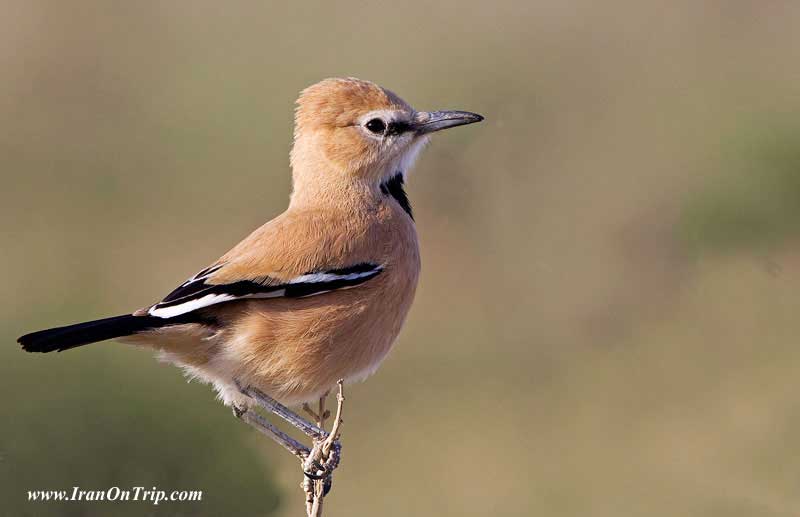pleske's Ground Jay

The Pleske's Ground Jay or Persian Ground Jay (Podoces pleskei) is a species of bird in the Corvidae family. It is endemic to Iran.
Iranian Ground Jay (Podoces pleskei) or Pleske's ground jay is one of the well known native species of deserts of the Caspio-Central Asian desert and to be specific; native to deserts alongside extreme east borders of Iran. The closer you get to the eastern central deserts of Iran the better chance of observing them you stand. One might mistake Iranian ground jay with Hoopoe Lark, But the coloring and plumage on Iranian ground jay is unique with no crest like Hoopoe Larks', only the look similar in shape and posture. Black bib is the key to distinguish Pleske's but lack of black bib on Juv. ground jays might be misleading. the distribution is known to be desert depressions of eastern Iran, mostly border habitats in Dusht-e-Lut of Khorasan and extreme Kerman. Northern most record from northern Semnan, south to Iranian Baluchistan.
Ground-Jay-Pleskes-Touran-IranGround jays or ground choughs belong to a distinct group of the passerine order of birds in the genus Podoces of the crow family Corvidae. They inhabit high altitude semi-desert areas from central Asia to Mongolia(All 4 species, while pleske's distribution is limited to eastern Iranian borders).
Ground jays show adaptations to ground living such as long, strong legs adapted to fast running and the ability to leap and bound onto boulders and rocks with great agility. Their long, curved thick bills are adapted for digging and probing.
While capable of flight (which they do infrequently and relatively weakly), they prefer running, and will readily perch on trees and bushes also.
Habitat
Could occur over border into Pakistani Baluchistan, perhaps even western Afghanistan. pleske's ground jay habitat is mostly semi-desertous plains with Zygophyllum atriplicoides known as "TAAGH" in persian (farsi) language.
Pleskes-Ground-Jay-Nestpleske's ground jay is common in Kerman Province and seen always in Shahr-e-Babak area. not through recent years though due to habitat loss. pleske's ground jay's name is "ZAGH-e-BOOR" in persian and natives call it "Soose' le'ng" which drives from it's jack hammer type of feeding while scavenging at the roadsides. they happen to search for where ever Zygophyllum steppe occurs as in eastern border of Iran and borders of Caspio-Central asian desert. If Zygophyllum is the scrub which grows to a hight of 0.5-1.5 m tall, with twisted, rather thick and juicy branches and small spoon-shaped leaves, few of which remained on the plants in autumn. It sometimes makes relatively thick growths. pleske's ground jay is active in habitats with more visible sand. They are active during dun and dusk, avoiding the noon heat.
The nest looks bushy like a magpie's but quiet deeper cone shaped, being as big but using thin branches compared to magpie's.
Pleske's ground jay usualy lay four small eggs, each one inch long(to my estimate), light cream colored mottled with reddish brown dots.
Behavior
Feeds in spring mainly on insects. Later in the year takes also grains and seeds. Known to hide food. Usually seen in pairs or in families of up to 6 birds and the breeding season starts in March. They build a spherical nest, camouflaged by a layer of interwoven twigs, among small shrubs. 3-6 pale blue-green eggs are laid. Only the female incubates, for 17-19 days, and the male feeds her while she is on the nest. The chicks grow fast, two weeks after hatching they are feathered.
A resident species with some dispersal movements in winter.
Current Condition
This species has a very large range, and hence does not approach the thresholds for Vulnerable under the range size criterion (Extent of Occurrence <20,000 km2 combined with a declining or fluctuating range size, habitat extent/quality, or population size and a small number of locations or severe fragmentation). The population trend appears to be stable, and hence the species does not approach the thresholds for Vulnerable under the population trend criterion (>30% decline over ten years or three generations). The population size has not been quantified, but it is not believed to approach the thresholds for Vulnerable under the population size criterion (<10,000 mature individuals with a continuing decline estimated to be >10% in ten years or three generations, or with a specified population structure). For these reasons the species is evaluated as Least.
.....
.....
.....

.jpg)



























